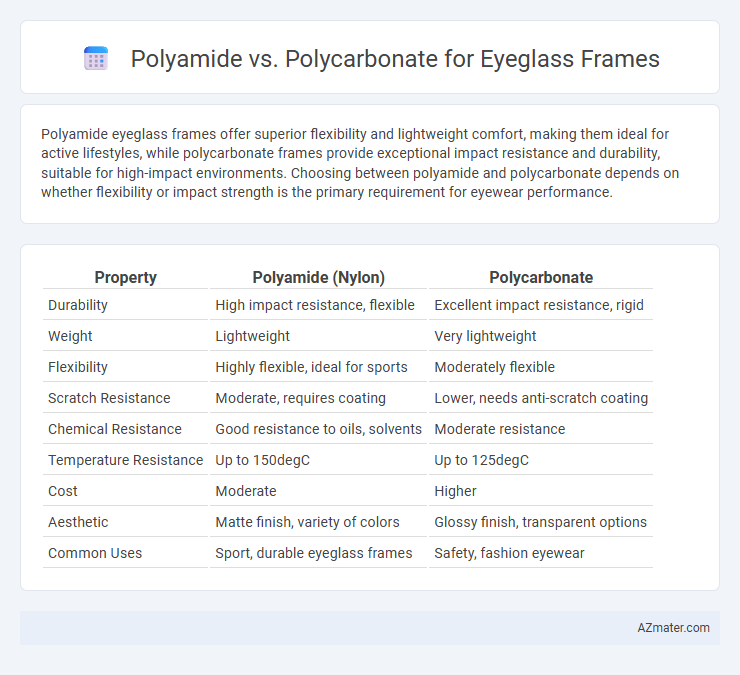Polyamide eyeglass frames offer superior flexibility and lightweight comfort, making them ideal for active lifestyles, while polycarbonate frames provide exceptional impact resistance and durability, suitable for high-impact environments. Choosing between polyamide and polycarbonate depends on whether flexibility or impact strength is the primary requirement for eyewear performance.
Table of Comparison
| Property | Polyamide (Nylon) | Polycarbonate |
|---|---|---|
| Durability | High impact resistance, flexible | Excellent impact resistance, rigid |
| Weight | Lightweight | Very lightweight |
| Flexibility | Highly flexible, ideal for sports | Moderately flexible |
| Scratch Resistance | Moderate, requires coating | Lower, needs anti-scratch coating |
| Chemical Resistance | Good resistance to oils, solvents | Moderate resistance |
| Temperature Resistance | Up to 150degC | Up to 125degC |
| Cost | Moderate | Higher |
| Aesthetic | Matte finish, variety of colors | Glossy finish, transparent options |
| Common Uses | Sport, durable eyeglass frames | Safety, fashion eyewear |
Introduction: Polyamide vs Polycarbonate Eyeglass Frames
Polyamide and polycarbonate are two popular materials used for eyeglass frames, each offering unique benefits in terms of durability and flexibility. Polyamide frames are lightweight, highly resistant to heat and chemicals, making them ideal for active lifestyles and harsh environments. Polycarbonate frames are known for their impact resistance and affordability, providing strong yet comfortable options for everyday wear.
Material Composition and Properties
Polyamide eyeglass frames consist of nylon-based polymers offering exceptional flexibility, lightweight comfort, and high resistance to impact and temperature variations, making them ideal for active lifestyles. Polycarbonate frames are crafted from thermoplastic polymers known for superior impact resistance, transparency, and UV protection, providing durability and safety, especially in sports or industrial eyewear. Both materials feature excellent resilience, but polyamide excels in flexibility and weight reduction, while polycarbonate offers enhanced optical clarity and toughness.
Durability and Resistance to Impact
Polycarbonate eyeglass frames offer superior impact resistance, making them an excellent choice for active lifestyles or environments with higher risk of physical stress. Polyamide frames, while generally lighter and more flexible, provide good durability but may not withstand extreme impacts as effectively as polycarbonate. Both materials resist daily wear and tear, but polycarbonate's toughness and shatterproof nature enhance its overall durability in eyewear applications.
Weight and Comfort Comparison
Polyamide eyeglass frames are known for their lightweight properties, providing enhanced comfort for prolonged wear due to their flexibility and resistance to impact. Polycarbonate frames, while slightly heavier, offer superior durability and impact resistance, making them ideal for active lifestyles but potentially less comfortable for all-day use. When prioritizing weight and comfort, polyamide frames generally outperform polycarbonate in reducing pressure on the nose and ears during extended wear.
Flexibility and Shape Retention
Polyamide eyeglass frames offer exceptional flexibility due to their lightweight and durable nylon-based composition, making them highly resistant to impact and deformation. Polycarbonate frames excel in shape retention because of their rigid thermoplastic structure, which maintains form even after significant stress or bending. While polyamide provides superior adaptability for active lifestyles, polycarbonate ensures long-lasting frame integrity especially in high-impact scenarios.
Aesthetic Options and Color Availability
Polyamide eyeglass frames offer a broad spectrum of vibrant colors and intricate patterns due to their flexible polymer structure, allowing for highly customizable and fashionable designs. Polycarbonate frames, while more limited in color range, provide a sleek, glossy finish with superior impact resistance, making them ideal for sporty or utilitarian styles. The choice between polyamide and polycarbonate frames often hinges on the desired balance between aesthetic versatility and durability.
Allergy and Skin Sensitivity Considerations
Polyamide eyeglass frames are highly regarded for their hypoallergenic properties, making them suitable for individuals with sensitive skin or allergies. Polycarbonate frames, while durable and impact-resistant, may occasionally cause irritation due to the presence of certain additives or coatings. Choosing polyamide over polycarbonate can reduce the risk of allergic reactions and skin sensitivity issues, particularly for long-term wearers.
Cost and Market Availability
Polyamide eyeglass frames typically cost less than polycarbonate frames due to lower production expenses and wide material accessibility, making them a budget-friendly choice for many consumers. Polycarbonate frames, known for impact resistance and durability, generally have higher price points but are widely available in both budget and premium eyewear markets. Market availability favors polyamide for mass-produced and affordable glasses, while polycarbonate dominates in sports and safety eyewear segments due to its strength and lightweight properties.
Environmental Impact and Sustainability
Polyamide eyeglass frames are derived from synthetic polymers, offering lightweight durability with moderate biodegradability under specific conditions, whereas polycarbonate frames are made from petroleum-based thermoplastic known for higher impact resistance but limited biodegradability. Polyamide's production generally consumes less energy and generates fewer greenhouse gases compared to polycarbonate manufacturing, making it a more sustainable choice for eco-conscious consumers. Recycling programs for polycarbonates are more established but often require specialized facilities, whereas polyamide recycling remains less common, impacting overall environmental footprints.
Choosing the Best Material for Your Eyeglass Frames
Polyamide offers exceptional flexibility and lightweight comfort, making it ideal for active lifestyles and long-term wear in eyeglass frames. Polycarbonate provides superior impact resistance and excellent optical clarity, perfect for safety glasses or highly durable everyday use. Choosing between polyamide and polycarbonate depends on your priorities for durability, flexibility, and comfort in eyewear frames.

Infographic: Polyamide vs Polycarbonate for Eyeglass Frame
 azmater.com
azmater.com